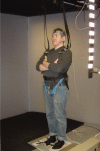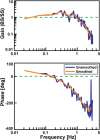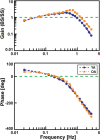Stiffness and damping in postural control increase with age
- PMID: 19770083
- PMCID: PMC3070169
- DOI: 10.1109/TBME.2009.2031874
Stiffness and damping in postural control increase with age
Abstract
Upright balance is believed to be maintained through active and passive mechanisms, both of which have been shown to be impacted by aging. A compensatory balance response often observed in older adults is increased co-contraction, which is generally assumed to enhance stability by increasing joint stiffness. We investigated the effect of aging on standing balance by fitting body sway data to a previously developed postural control model that includes active and passive stiffness and damping parameters. Ten young (24 +/- 3 years) and seven older (75 +/- 5 years) adults were exposed during eyes-closed stance to perturbations consisting of lateral pseudorandom floor tilts. A least-square fit of the measured body sway data to the postural control model found significantly larger active stiffness and damping model parameters in the older adults. These differences remained significant even after normalizing to account for different body sizes between the young and older adult groups. An age effect was also found for the normalized passive stiffness, but not for the normalized passive damping parameter. This concurrent increase in active stiffness and damping was shown to be more stabilizing than an increase in stiffness alone, as assessed by oscillations in the postural control model impulse response.
Figures







References
-
- van der Kooij H, van Asseldonk E, van der Helm FC. Comparison of different methods to identify and quantify balance control. J Neurosci Methods. 2005 Jun 30;145:175–203. - PubMed
-
- Peterka RJ. Simplifying the complexities of maintaining balance. IEEE Eng Med Biol Mag. 2003;22:63–68. - PubMed
-
- Horak FB, Macpherson JM. Postural Orientation and Equilibrium. In: Rowell LB, Shepherd JT, editors. Exercise: Regulation and Integration of Multiple Systems. Oxford University Press; New York, NY: 1996. pp. 255–292.
-
- Peterka RJ. Sensorimotor integration in human postural control. Journal of Neurophysiology. 2002 Sep;88:1097–1118. - PubMed
Publication types
MeSH terms
Grants and funding
LinkOut - more resources
Full Text Sources
Medical

